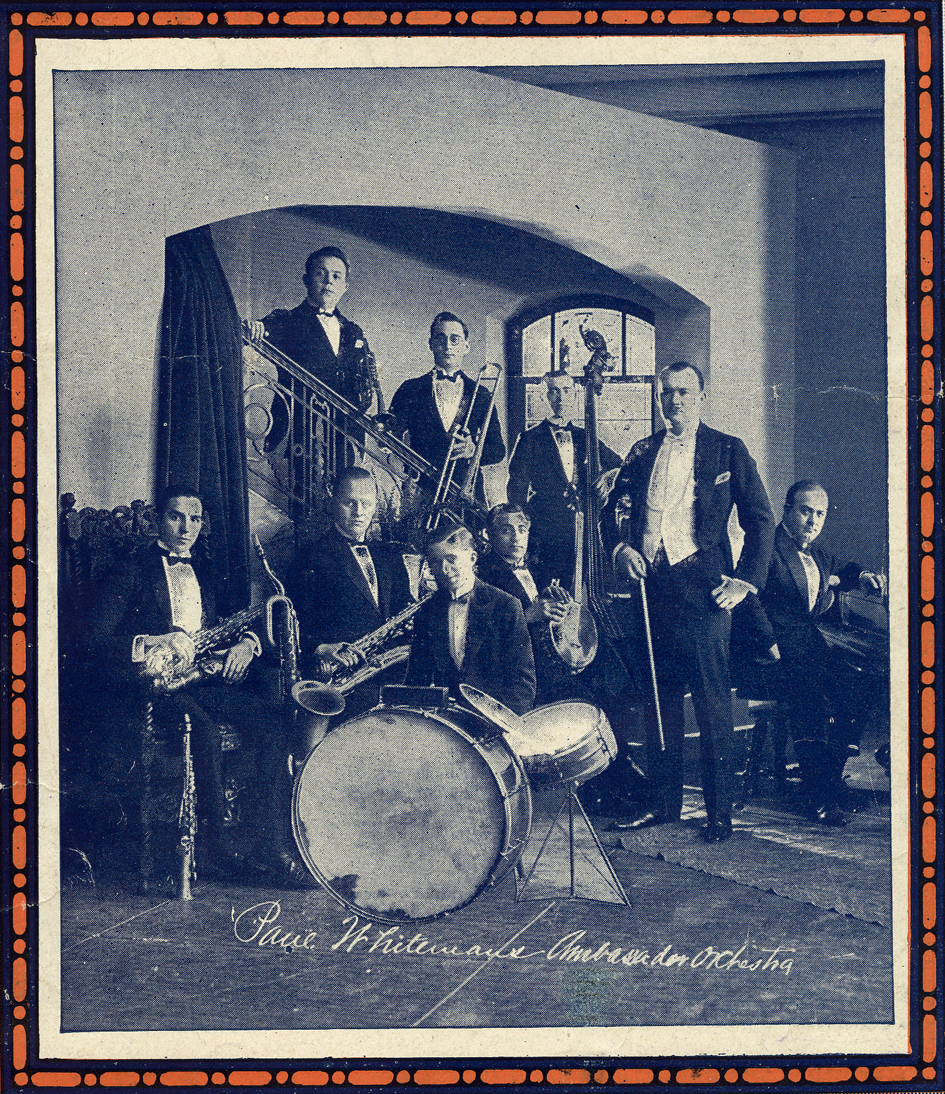- Paul Whiteman
Infobox musical artist
Name = Paul Whiteman

Img_capt = Paul Whiteman and his orchestra in 1921. Photo from the sheet music issue of the band's early hit recording "Wang Wang Blues"
Img_size = 200
Landscape =
Background = non_performing_personnel
Birth_name = Paul Whiteman
Alias =
Born = birth date|1890|3|28
Died = death date and age|1967|12|29|1890|3|28
Origin =Denver, Colorado , U.S.
Instrument =violin
Voice_type =
Genre =Jazz
Occupation =Bandleader Composer
Years_active =
Label =
Associated_acts =Bix Beiderbecke Frankie Trumbauer Joe Venuti Eddie Lang
URL =
Current_members =
Past_members =
Notable_instruments = Paul Whiteman (March 28 ,1890 –December 29 ,1967 ) was an American orchestral leader. He was born inDenver, Colorado . After a start as a classicalviolin ist and violist, Whiteman then led a jazz-influenced dance band, which became locally popular inSan Francisco, California in 1918. In 1920 he moved his band toNew York City where they started making recordings for Victor Records which propelled Whiteman and his band to national prominence. Whiteman became the most popular band leader of the decade. In May, 1928, he signed withColumbia Records , only to return to Victor September, 1931, where he stayed until March, 1937.In the 1920s, Whiteman controversially dubbed himself The King of Jazz (see:
Jazz royalty ) and he wore this title with pride. He acknowledged the African American roots of the genre and never claimed to be a pioneer of the genre, but rather emphasized the way he'd approached the already well-established style of music while organizing its composition and style in his own fashion. He recordedHoagy Carmichael singing and playing "Washboard Blues " to the accompaniment of his orchestra in 1927.cite book
first= Alec
last= Wilder
authorlink=
coauthors=
year= 1990
title= American Popular Song: The Great Innovators 1900-1950
edition=
publisher= Oxford University Press
location= New York & Oxford
id= ISBN 0-19-501445-6 ]While today most fans of
jazz consider improvisation to be essential to the musical style, Whiteman thought the music could be improved by orchestrating the best of it, with formal arrangements. In a time when most dance bands consisted of six to 10 men, Whiteman led a much larger and more imposing group, numbering as many as 35 musicians. Whiteman's recordings were critically popular and commercially successful, and his more respectable brand of jazz music was often the first jazz of any form that some people heard. For more than 30 years, Paul Whiteman sought out and encouraged musicians, vocalists, composers, arrangers, and entertainers who looked promising. In 1924 Whiteman commissionedGeorge Gershwin 's "Rhapsody in Blue ", which was premiered by Whiteman's orchestra with Gershwin at the piano. Another familiar piece in Whiteman's repertoire was "Grand Canyon Suite ", byFerde Grofé .Whiteman hired many of the best white
jazz men for his band, includingBix Beiderbecke ,Frankie Trumbauer ,Joe Venuti ,Eddie Lang , Steve Brown,Mike Pingitore ,Gussie Mueller , Wilbur Hall (billed by Whiteman as "Willie Hall"),Jack Teagarden , andBunny Berigan . He'd also encouraged upcoming African American musical talents, but due to the racial tension of that time, he never succeeded in recruiting any. In late 1926 he signed three candidates for his orchestra:Bing Crosby ,Al Rinker , andHarry Barris . Whiteman billed the singing trio as his Rhythm Boys. Crosby's prominence in the Rhythm Boys helped launch his career as one of the most successful singers of the 20th century.Whiteman signed
Mildred Bailey in 1929 (although she didn't record with Whiteman until 1931). It has been reported in a couple of recent books that Whiteman wanted to hire black musicians back in the late 1920s, but he was talked out of it by his management and record company.Jazz musician, turned crooner
Red McKenzie and cabaret singerRamona Davies (billed as "Ramona and her Grand Piano") joined the Whiteman group in 1932. TheKing's Jesters where with Whiteman in 1931. In 1930 "Paul Whiteman and his Orchestra" starred in the first feature-length movie musical filmed entirely inTechnicolor , "King of Jazz ". The film was technically ahead of its time, with many dazzling camera effects complementing the Whiteman music. Whiteman appeared as himself, and good-naturedly kidded his weight and his dancing skills. A highlight was a concert rendition of "Rhapsody in Blue ". Unfortunately, by the time "King of Jazz " was released to theaters, audiences had seen too many "all-singing, all-dancing" musicals, and much of the moviegoing public stayed away. The expensive film didn't show a profit until 1933, when it was successfully reissued to cash in on the popularity of "42nd Street " and its elaborate production numbers.In 1931, Whiteman married motion picture actress
Margaret Livingston .In 1933, Whiteman had a #2 hit on the "
Billboard " charts with the song, "Willow Weep for Me ". [Whitburn, Joel (1996). "The Billboard Book of Top 40 Hits", 6th Edition (Billboard Publications)]In the 1940s and 1950s, after he had disbanded his orchestra, Whiteman worked as a music director for the ABC Radio Network. He also hosted several
television programs and continued to appear as guest conductor for many concerts. His manner on stage was disarming; he signed off each program with something casual like, "Well, that just about slaps the cap on the old milk bottle for tonight."Duke Ellington wrote in his autobiography: "Paul Whiteman was known as the King of Jazz, and no one as yet has come near carrying that title with more certainty and dignity."Paul Whiteman died at the age of 77 in
Doylestown, Pennsylvania .Quotations
"Jazz tickles your muscles, symphonies stretch your soul."
"Jazz is the folk music of the machine age."
"Jazz came to America three hundred years ago in chains."
Notes
External links
Wikimedia Foundation. 2010.
